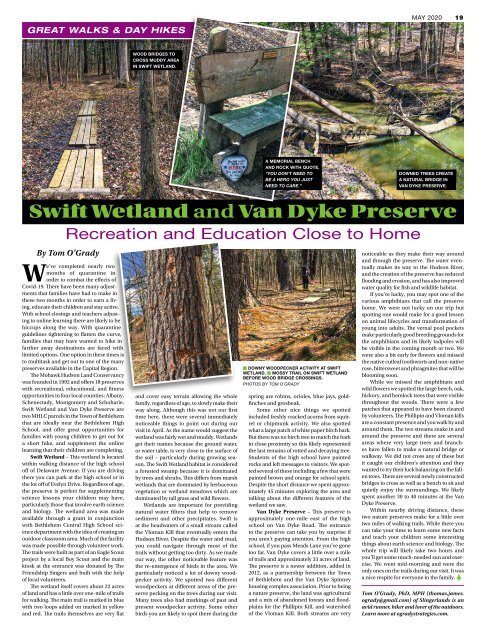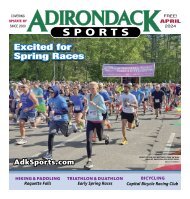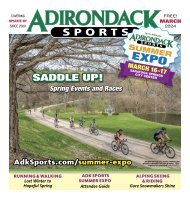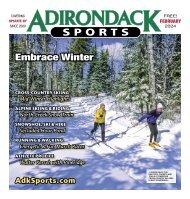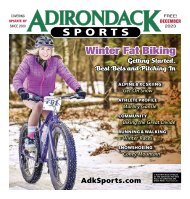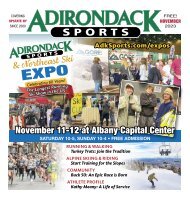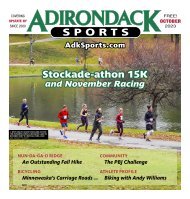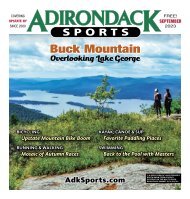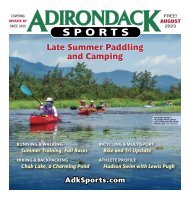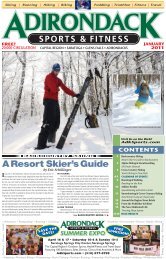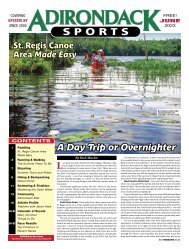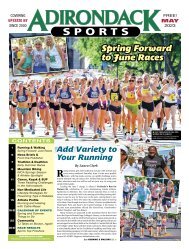Adirondack Sports May 2020
In This Issue: BICYCLING - Find Your Own Trail Ride PADDLING - Lessons I Have Learned From the Publisher & News Briefs RUNNING - Running Reinvention HIKING & PACKPACKING - Big Bad Luck ATHLETE PROFILE - Mountain Biking with Anna Laloë CALENDAR OF EVENTS - Canceled, Postponed, Virtual & Happening Events! GREAT WALKS & DAY HIKES - Close to Home: Swift Wetland and Van Dyke Preserve
In This Issue:
BICYCLING - Find Your Own Trail Ride
PADDLING - Lessons I Have Learned
From the Publisher & News Briefs
RUNNING - Running Reinvention
HIKING & PACKPACKING - Big Bad Luck
ATHLETE PROFILE - Mountain Biking with Anna Laloë
CALENDAR OF EVENTS - Canceled, Postponed, Virtual & Happening Events!
GREAT WALKS & DAY HIKES - Close to Home: Swift Wetland and Van Dyke Preserve
Create successful ePaper yourself
Turn your PDF publications into a flip-book with our unique Google optimized e-Paper software.
GREAT WALKS & DAY HIKES<br />
MAY <strong>2020</strong> 19<br />
WOOD BRIDGES TO<br />
CROSS MUDDY AREA<br />
IN SWIFT WETLAND.<br />
A MEMORIAL BENCH<br />
AND ROCK WITH QUOTE,<br />
“YOU DON’T NEED TO<br />
BE A HERO YOU JUST<br />
NEED TO CARE.”<br />
DOWNED TREES CREATE<br />
A NATURAL BRIDGE IN<br />
VAN DYKE PRESERVE.<br />
Swift Wetland and Van Dyke Preserve<br />
Recreation and Education Close to Home<br />
By Tom O’Grady<br />
We’ve completed nearly two<br />
months of quarantine in<br />
order to combat the effects of<br />
Covid-19. There have been many adjustments<br />
that families have had to make in<br />
these two months in order to earn a living,<br />
educate their children and stay active.<br />
With school closings and teachers adjusting<br />
to online learning there are likely to be<br />
hiccups along the way. With quarantine<br />
guidelines tightening to flatten the curve,<br />
families that may have wanted to hike in<br />
farther away destinations are faced with<br />
limited options. One option in these times is<br />
to multitask and get out to one of the many<br />
preserves available in the Capital Region.<br />
The Mohawk Hudson Land Conservancy<br />
was founded in 1992 and offers 18 preserves<br />
with recreational, educational, and fitness<br />
opportunities in four local counties: Albany,<br />
Schenectady, Montgomery and Schoharie.<br />
Swift Wetland and Van Dyke Preserve are<br />
two MHLC parcels in the Town of Bethlehem<br />
that are ideally near the Bethlehem High<br />
School, and offer great opportunities for<br />
families with young children to get out for<br />
a short hike, and supplement the online<br />
learning that their children are completing.<br />
Swift Wetland – This wetland is located<br />
within walking distance of the high school<br />
off of Delaware Avenue. If you are driving<br />
there you can park at the high school or in<br />
the lot off of Evelyn Drive. Regardless of age,<br />
the preserve is perfect for supplementing<br />
science lessons your children may have,<br />
particularly those that involve earth science<br />
and biology. The wetland area was made<br />
available through a grant in conjunction<br />
with Bethlehem Central High School science<br />
department with the idea of creating an<br />
outdoor classroom area. Much of the facility<br />
was made possible through volunteer work.<br />
The trails were built as part of an Eagle Scout<br />
project by a local Boy Scout and the main<br />
kiosk at the entrance was donated by The<br />
Friendship Singers and built with the help<br />
of local volunteers.<br />
The wetland itself covers about 22 acres<br />
of land and has a little over one-mile of trails<br />
for walking. The main trail is marked in blue<br />
with two loops added on marked in yellow<br />
and red. The trails themselves are very flat<br />
and cover easy terrain allowing the whole<br />
family, regardless of age, to slowly make their<br />
way along. Although this was not our first<br />
time here, there were several immediately<br />
noticeable things to point out during our<br />
visit in April. As the name would suggest the<br />
wetland was fairly wet and muddy. Wetlands<br />
get their names because the ground water,<br />
or water table, is very close to the surface of<br />
the soil – particularly during growing season.<br />
The Swift Wetland habitat is considered<br />
a forested swamp because it is dominated<br />
by trees and shrubs. This differs from marsh<br />
wetlands that are dominated by herbaceous<br />
vegetation or wetland meadows which are<br />
dominated by tall grass and wild flowers.<br />
Wetlands are important for providing<br />
natural water filters that help to remove<br />
sediment and other precipitates. Swift is<br />
at the headwaters of a small stream called<br />
the Vloman Kill that eventually enters the<br />
Hudson River. Despite the water and mud,<br />
you could navigate through most of the<br />
trails without getting too dirty. As we made<br />
our way, the other noticeable feature was<br />
the re-emergence of birds in the area. We<br />
particularly noticed a lot of downy woodpecker<br />
activity. We spotted two different<br />
woodpeckers at different areas of the preserve<br />
pecking on the trees during our visit.<br />
Many trees also had markings of past and<br />
present woodpecker activity. Some other<br />
birds you are likely to spot there during the<br />
■ DOWNY WOODPECKER ACTIVITY AT SWIFT<br />
WETLAND. ■ MOSSY TRAIL ON SWIFT WETLAND<br />
BEFORE WOOD BRIDGE CROSSINGS.<br />
PHOTOS BY TOM O’GRADY<br />
spring are robins, orioles, blue jays, goldfinches<br />
and grosbeak.<br />
Some other nice things we spotted<br />
included freshly cracked acorns from squirrel<br />
or chipmunk activity. We also spotted<br />
what a large patch of white paper birch bark.<br />
But there was no birch tree to match the bark<br />
in close proximity so this likely represented<br />
the last remains of rotted and decaying tree.<br />
Students of the high school have painted<br />
rocks and left messages to visitors. We spotted<br />
several of these including a few that were<br />
painted brown and orange for school spirit.<br />
Despite the short distance we spent approximately<br />
45 minutes exploring the area and<br />
talking about the different features of the<br />
wetland we saw.<br />
Van Dyke Preserve – This preserve is<br />
approximately one-mile east of the high<br />
school on Van Dyke Road. The entrance<br />
to the preserve can take you by surprise if<br />
you aren’t paying attention. From the high<br />
school, if you pass Meads Lane you’ve gone<br />
too far. Van Dyke covers a little over a mile<br />
of trails and approximately 33 acres of land.<br />
The preserve is a newer addition, added in<br />
2012, as a partnership between the Town<br />
of Bethlehem and the Van Dyke Spinney<br />
housing complex association. Prior to being<br />
a nature preserve, the land was agricultural<br />
and a mix of abandoned forests and floodplains<br />
for the Phillipin Kill, and watershed<br />
of the Vloman Kill. Both streams are very<br />
noticeable as they make their way around<br />
and through the preserve. The water eventually<br />
makes its way to the Hudson River,<br />
and the creation of the preserve has reduced<br />
flooding and erosion, and has also improved<br />
water quality for fish and wildlife habitat.<br />
If you’re lucky, you may spot one of the<br />
various amphibians that call the preserve<br />
home. We were not lucky on our trip but<br />
spotting one would make for a good lesson<br />
on animal lifecycles and transformation of<br />
young into adults. The vernal pool pockets<br />
make particularly good breeding grounds for<br />
the amphibians and its likely tadpoles will<br />
be visible in the coming month or two. We<br />
were also a bit early for flowers and missed<br />
the native cutleaf toothworts and non-native<br />
rose, bittersweet and phragmites that will be<br />
blooming soon.<br />
While we missed the amphibians and<br />
wild flowers we spotted the large beech, oak,<br />
hickory, and hemlock trees that were visible<br />
throughout the woods. There were a few<br />
patches that appeared to have been cleared<br />
by volunteers. The Phillipin and Vloman kills<br />
are a constant presence and you walk by and<br />
around them. The two streams snake in and<br />
around the preserve and there are several<br />
areas where very large trees and branches<br />
have fallen to make a natural bridge or<br />
walkway. We did not cross any of these but<br />
it caught our children’s attention and they<br />
wanted to try their luck balancing on the fallen<br />
trees. There are several newly constructed<br />
bridges to cross as well as a bench to sit and<br />
quietly enjoy the surroundings. We likely<br />
spent another 30 to 40 minutes at the Van<br />
Dyke Preserve.<br />
Within nearby driving distance, these<br />
two nature preserves make for a little over<br />
two miles of walking trails. While there you<br />
can take your time to learn some new facts<br />
and teach your children some interesting<br />
things about earth science and biology. The<br />
whole trip will likely take two hours and<br />
you’ll get some much-needed sun and exercise.<br />
We went mid-morning and were the<br />
only ones on the trails during our visit. It was<br />
a nice respite for everyone in the family.<br />
Tom O’Grady, PhD, MPH (thomas.james.<br />
ogrady@gmail.com) of Slingerlands is an<br />
avid runner, hiker and lover of the outdoors.<br />
Learn more at ogradystrategies.com.


